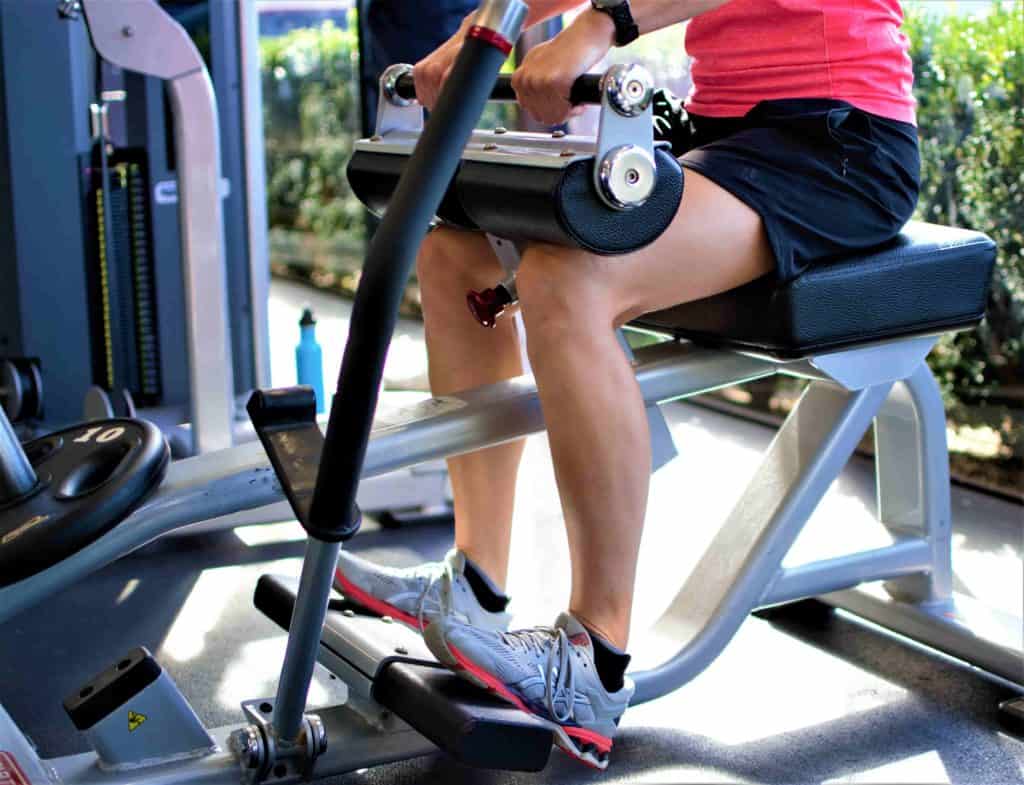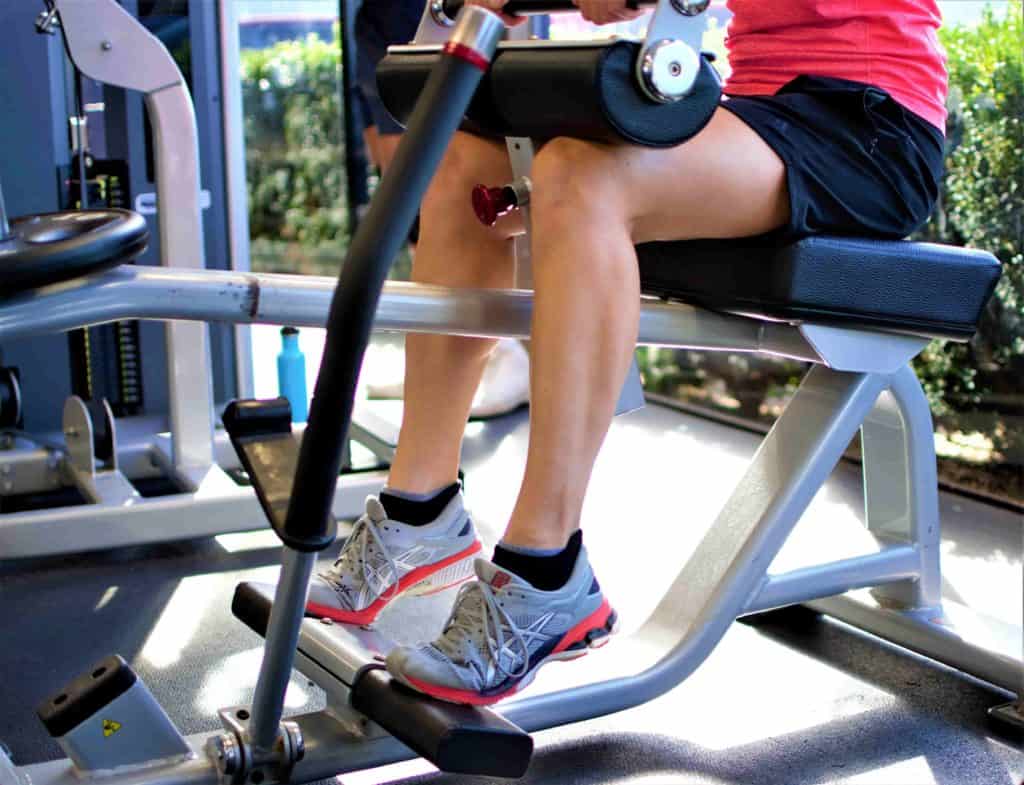
Kim Hoffman
NASM CES (Corrective Exercise Specialist) and Certified Personal Trainer
Note — The article was checked and updated November 2023.
What’s special about calves and why should we train them?
Calves are aesthetically appealing, but they also have an important function during movement and exercise. Some of the functions include:
- Absorbing the load with each impact (walking, running or jumping)
- Propelling us forward when sprinting
- Supporting our body when standing
By “stressing” our calf muscles through training, we will:
- Move well and without pain
- Become faster
- Be able to run for longer
- Keep a more consistent pace while running
Important to mention is that if not at their optimal length, calves can pull other muscles out of alignment.
The calves — function and anatomy
The lower leg muscles are attached to two major joints – the knee and the ankle. How well we can move these joints depends on how optimal the muscles function.
Knees
- Flexion = bending the leg
- Extension = straightening the leg
Feet
- Toe flexion and extension = pointing and pulling toes up without moving the foot
- Foot inversion = standing more on the outside of our feet
- Foot eversion = the sole of the foot caves in and flattens
- Foot adduction = the foot moves towards midline
- Foot abduction = the foot moves away from midline and body
Ankles
- Plantar flexion = pointing our toes and the whole foot moves
- Dorsiflexion = pulling toes toward our body and the whole foot comes up
- Supination = combination of 3 movements – plantar flexion, inversion and foot adduction
- Pronation = combination of 3 movements – dorsiflexion, eversion and foot abduction
When it comes to the calf muscles, the two main superficial muscles are:
- Gastrocnemius
- Soleus
The deeper muscles of the calf include:
- Posterior Tibialis
- Fibularis Longus (also known as peroneus longus)
- Flexor Digitorum Longus
- Flexor Hallucis Longus
On the front of the lower leg, we have:
- Tibialis Anterior
- Extensor Digitorum Longus
- Extensor Hallucis Longus


All the muscles in the calves have a similar function which is to extend the ankle. The muscles on the shins (extensors and the tibialis anterior) bring the toes toward the body.
In our previous article, we’ve talked about issues that you can experience with calf muscles. Before heading off to the gym, I would encourage you to read it.
RELATED — Common issues with calf muscles
Exercises for gastrocnemius
Because of the gastrocnemius’ attachment to the knee and the ankle, it works both these joints. For this reason, we want to keep our knees straight when working the calves.
The gastrocnemius muscle consists mostly of type 2 fibres
Type 2 muscle fibres are fast twitch fibres that we need for sprinting and jumping. This means that muscles consisting of type 2 fibres respond better to higher weight with less repetitions (8-12 reps).
Calf raises - standing


Heel raise walks


Walking uphill or downhill also strengthens calf muscles.
Exercises for soleus
Because the soleus attaches to the bones of the lower leg and the Achilles tendon, it only works the ankle joint, and not the knee. That is why we want to keep our knees bent at 90 degrees when working the soleus.
The soleus muscle consists of mostly type 1 fibres
Type 1 muscle fibres are fatigue resistant. This means that we use them for aerobic and endurance-type activities, such as maintaining posture, walking, jogging and long-distance running.
RELATED — Your Guide to Good Posture
For the soleus muscle we should aim for 20-25 repetitions, with lighter weight.
Calf raises - seated (machine)


Calf raises - seated (with dumbbells)
Like the seated calf raises, there is an alternative to standing calf raises on the machine, which is doing them on a low wall or box, with or without dumbbells.
The main reason people would choose a dumbbell or non-machine version is their height.
Short people can’t perform the exercise on the standing or seated machine because they can’t bring their heels down (standing machine) or move the roller for the thighs (seated machine).
I don’t particularly like the seated calf raises because the roller digs into my legs. But you are able to lift more weight with the machine.


Important note
The body is a kinetic chain which means that everything in our body is connected, from our muscles to our tendons and bones.
This means that when we do a movement or exercise, it is never just one muscle that does the work.
The same goes for the calves. Because the calf muscles connect on the in- and outside of the knee, they also work during quad and hamstring exercises.
Related Questions
1. What is the best way to keep the calves from getting tight(er)?
Try to limit how often and how long you wear shoes with (higher) heels.
Also, when sitting at your desk, try to change your posture as often as possible as this keeps the muscles active.
RELATED — Bad posture can impact your health: Getting it straight
2. How often can I train calves?
The short answer is: as often as you like.
Like the abs, the calves seem to recover from workouts more quickly than other muscle groups (quads, hamstring, back and chest).
Because of that, training them more intensively and more often can deliver better results.
3. When should I train my calves?
Most people train calf muscles after they train their thighs. This is mainly because most of the exercises that target the quadriceps also involve the calf muscles.
Training calves after quads will also allow you to take advantage of the blood build-up in the legs to bring growth-producing nutrients into the calves during your workout.
For more guides on exercises, please see our Activities and Performance page.
Kim Hoffmann is a certified Personal Trainer and Corrective Exercise Specialist based in Auckland. She also specialises in women’s health and fitness by taking into consideration the menstrual cycle and hormones and implementing them in different workout plans. The workout methods and routines include free weights, suspension straps and boxing, as well as strength training and high intensity.
Kim’s passion is helping people move better and improve their quality of life. She helps men and women of all ages achieve their goals and also offers online classes and consultations. You can see more of Kim at Snatch Fitness.






